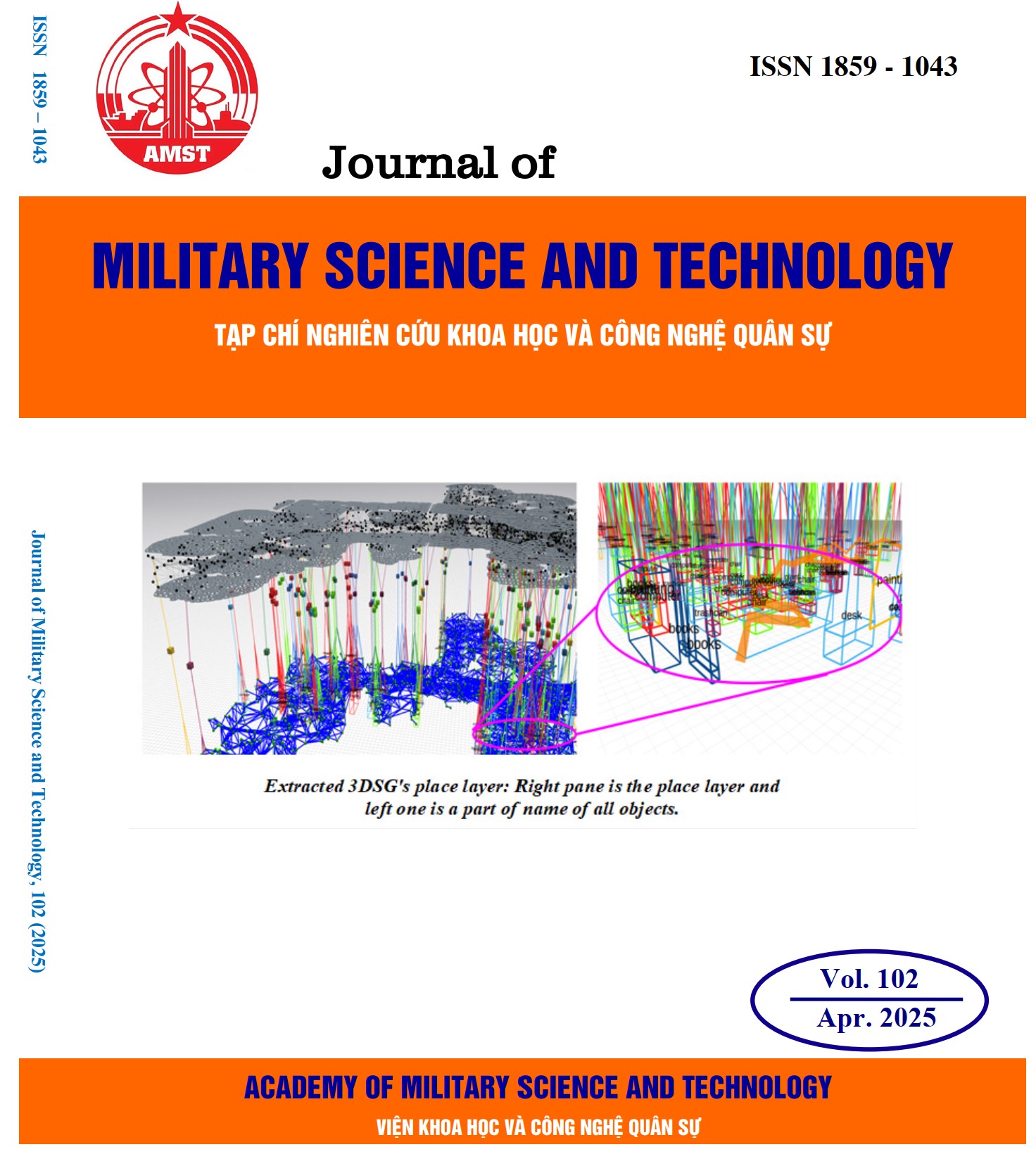Than sinh học tẩm cobalt có nguồn gốc từ xơ dừa hoạt hóa peroxymonosulfate để phân hủy methylene blue
572 lượt xemDOI:
https://doi.org/10.54939/1859-1043.j.mst.102.2025.76-83Từ khóa:
Than sinh học; Thuốc nhuộm; Chất hoạt hóa PMS; Cobalt; Sinh khối.Tóm tắt
Trong nghiên cứu này, than sinh học tẩm kim loại (Co-Biochar), đóng vai trò là chất hoạt hóa peroxymonosulfate (PMS) để phân hủy Methylene blue (MB) có trong nước. Quá trình này đóng vai trò then chốt trong việc biến chất thải thành vật liệu có giá trị. Than sinh học được tổng hợp từ xơ dừa bằng quá trình nhiệt phân trong môi trường khí trơ và sau đó biến tính với muối kim loại bằng phương pháp đồng kết tủa. Các đặc tính cấu trúc của vật liệu được phân tích bằng các phương pháp phân tích hiện đại như kính hiển vi điện tử quét (SEM), phổ tán sắc năng lượng nguyên tử (EDS), đường đẳng nhiệt hấp phụ-giải hấp phụ N2. Vật liệu xúc tác sau khi hoạt hóa PMS cho thấy hiệu quả cao trong việc xử lý MB. Trong điều kiện cụ thể 0,05 g chất xúc tác, 100 mL dung dịch MB 50 mg/L và 400 mg/L PMS, hiệu suất loại bỏ MB khoảng hơn 90% sau 10 phút. Ngoài ra, ảnh hưởng của điều kiện phản ứng như hàm lượng xúc tác, hàm lượng PMS và pH dung dịch đã được nghiên cứu. Kết quả nghiên cứu cho thấy vật liệu có tiềm năng trong việc hoạt hóa PMS xử lý MB có trong nước thải dệt nhuộm.
Tài liệu tham khảo
[1]. H. Ouasif et al., "Removal of a cationic dye from wastewater by adsorption onto natural adsorbents", Journal of Materials and Environmental Science, Vol.4, 1-10, (2013).
[2]. H. M. Solayman et al., "Performance evaluation of dye wastewater treatment technologies: A review", Journal of Environmental Chemical Engineering, Vol.11, 3, 109610, (2023). DOI: https://doi.org/10.1016/j.jece.2023.109610
[3]. K. Piaskowski et al., "Dye Removal from Water and Wastewater Using Various Physical, Chemical, and Biological Processes", AOAC Int, Vol.101, 5, 1371-1384, (2018). DOI: https://doi.org/10.5740/jaoacint.18-0051
[4]. Y. M. Sgibnev et al., "A comparative study of photocatalytic activity of Na+–Ag+ ion-exchanged glass-ceramics with metallic Ag, semiconductor AgBr, and hybrid Ag–AgBr nanoparticles", Dalton Transactions, Vol.52, 36, 12661-12667, (2023). DOI: https://doi.org/10.1039/D3DT01712E
[5]. K. Sathishkumar et al., "Electrochemical decolorization of methyl red by RuO(2)-IrO(2)-TiO(2) electrode and biodegradation with Pseudomonas stutzeri MN1 and Acinetobacter baumannii MN3: An integrated approach", Chemosphere, Vol.183, 204-211, (2017). DOI: https://doi.org/10.1016/j.chemosphere.2017.05.087
[6]. S. K. M. Nzaba et al., "Comparative study of visible-light active BiOI and N,Pd-TiO2 photocatalysts: Catalytic ozonation for dye degradation", Colloids and Surfaces A: Physicochemical and Engineering Aspects, Vol.684, (2024). DOI: https://doi.org/10.1016/j.colsurfa.2024.133167
[7]. H. Kumari et al., "A review on photocatalysis used for wastewater treatment: dye degradation", Water, Air, Soil Pollution, Vol.234, 6, 349, (2023). DOI: https://doi.org/10.1007/s11270-023-06359-9
[8]. R. Tanveer et al., "Integration of physical and advanced oxidation processes for treatment and reuse of textile dye-bath effluents with minimum area footprint", Journal of Cleaner Production, Vol.383, 135366, (2023). DOI: https://doi.org/10.1016/j.jclepro.2022.135366
[9]. X. Pang et al., "LaCoO3 perovskite oxide activation of peroxymonosulfate for aqueous 2-phenyl-5-sulfobenzimidazole degradation: Effect of synthetic method and the reaction mechanism", Chemical Engineering Journal, Vol.304, 897-907, (2016). DOI: https://doi.org/10.1016/j.cej.2016.07.027
[10]. B.-T. Zhang et al., "Sulfate radical and its application in decontamination technologies", Critical Reviews in Environmental Science Technology, Vol.45, 16, 1756-1800, (2015). DOI: https://doi.org/10.1080/10643389.2014.970681
[11]. D. Zhou et al., "Sulfur‐replaced Fenton systems: can sulfate radical substitute hydroxyl radical for advanced oxidation technologies?", Journal of Chemical Technology Biotechnology, Vol.90, 5, 775-779, (2015). DOI: https://doi.org/10.1002/jctb.4525
[12]. F. Ghanbari et al., "Application of peroxymonosulfate and its activation methods for degradation of environmental organic pollutants: Review", Chemical Engineering Journal, Vol.310, 41-62, (2017). DOI: https://doi.org/10.1016/j.cej.2016.10.064
[13]. G. P. Anipsitakis et al., "Radical generation by the interaction of transition metals with common oxidants", Vol.38, 13, 3705-3712, (2004). DOI: https://doi.org/10.1021/es035121o
[14]. B. Bayatsarmadi et al., "Recent Advances in Atomic Metal Doping of Carbon-based Nanomaterials for Energy Conversion", Small, Vol.13, 21 (2017), DOI: https://doi.org/10.1002/smll.201700191
[15]. S. Xiao et al., "Iron-mediated activation of persulfate and peroxymonosulfate in both homogeneous and heterogeneous ways: a review", Vol.384, 123265, (2020). DOI: https://doi.org/10.1016/j.cej.2019.123265
[16]. M. T. Yang et al., "Cobalt-impregnated biochar produced from CO(2)-mediated pyrolysis of Co/lignin as an enhanced catalyst for activating peroxymonosulfate to degrade acetaminophen", Chemosphere, Vol.226, 924-933, (2019). DOI: https://doi.org/10.1016/j.chemosphere.2019.04.004
[17]. J. Liu et al., "Peroxymonosulfate activation by cobalt particles embedded into biochar for levofloxacin degradation: Efficiency, stability, and mechanism", Separation and Purification Technology, Vol.294, (2022). DOI: https://doi.org/10.1016/j.seppur.2022.121082
[18]. V. T. Nguyen et al., "Cobalt-impregnated biochar (Co-SCG) for heterogeneous activation of peroxymonosulfate for removal of tetracycline in water", Bioresour Technol, Vol.292, (2019), 121954. DOI: https://doi.org/10.1016/j.biortech.2019.121954
[19]. J. Wang et al., "Preparation, modification and environmental application of biochar: A review", Vol.227, 1002-1022, (2019). DOI: https://doi.org/10.1016/j.jclepro.2019.04.282
[20]. D. V. Cử, "Vị thế cây dừa Việt Nam," Sở khoa học và Công nghệ Bến Tre (2024), Available: http://dost-bentre.gov.vn/tin-tuc/3257/vi-the-cay-dua-viet-nam (in Vietnamese).
[21]. S. F. Guarnieri et al., "Coconut fiber biochar alters physical and chemical properties in sandy soils", Acta Scientiarum. Agronomy, Vol.43, (2021), DOI: https://doi.org/10.4025/actasciagron.v43i1.51801
[22]. Y. Lee et al., "Comparison of biochar properties from biomass residues produced by slow pyrolysis at 500 degrees C", Bioresour Technol, Vol.148, 196-201, (2013). DOI: https://doi.org/10.1016/j.biortech.2013.08.135
[23]. J. I. Hedges et al., "The molecularly-uncharacterized component of nonliving organic matter in natural environments", Vol.31, 10, 945-958, (2000). DOI: https://doi.org/10.1016/S0146-6380(00)00096-6
[24]. K. A. Spokas, "Review of the stability of biochar in soils: predictability of O: C molar ratios", (2010). DOI: https://doi.org/10.4155/cmt.10.32







